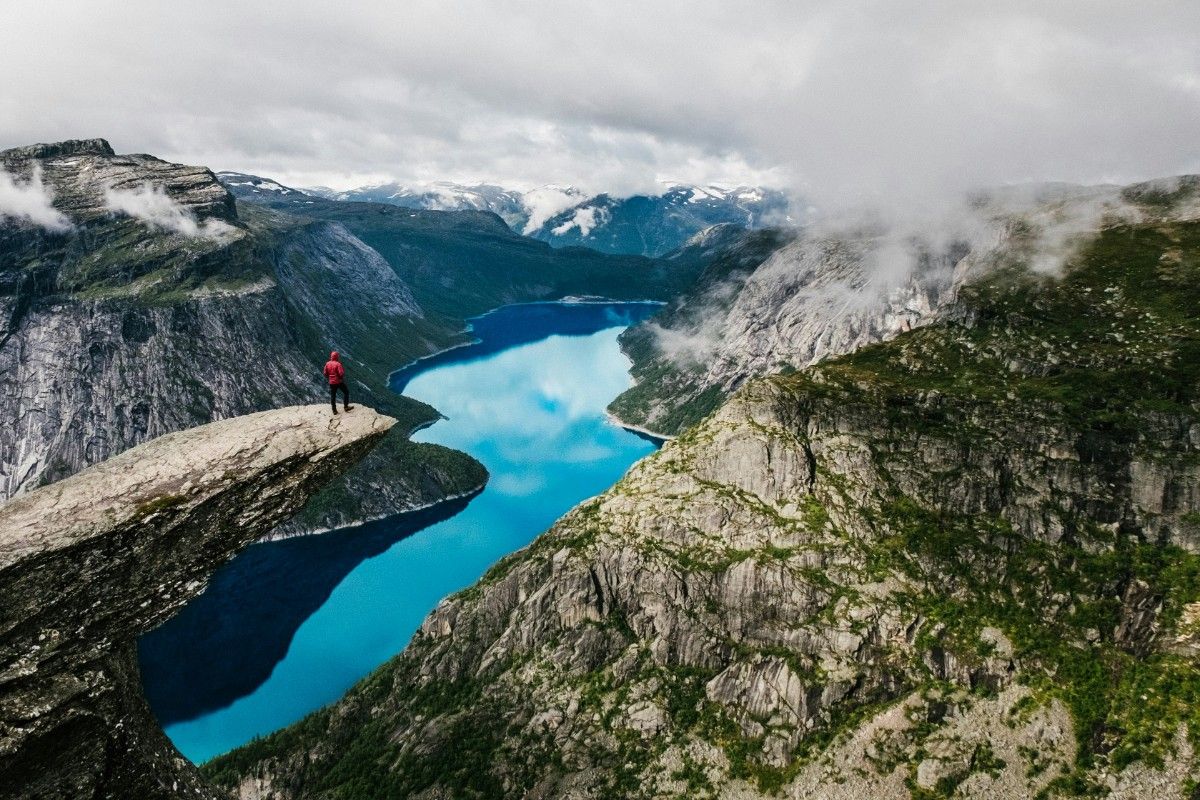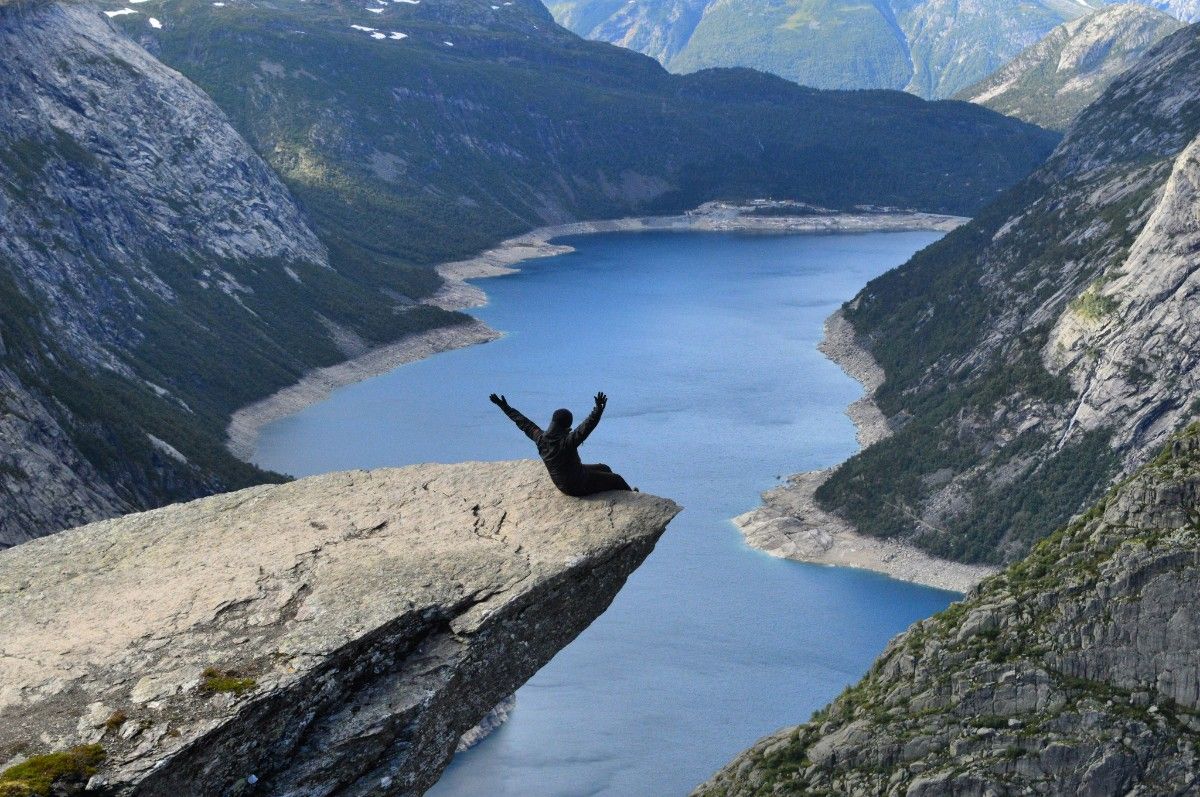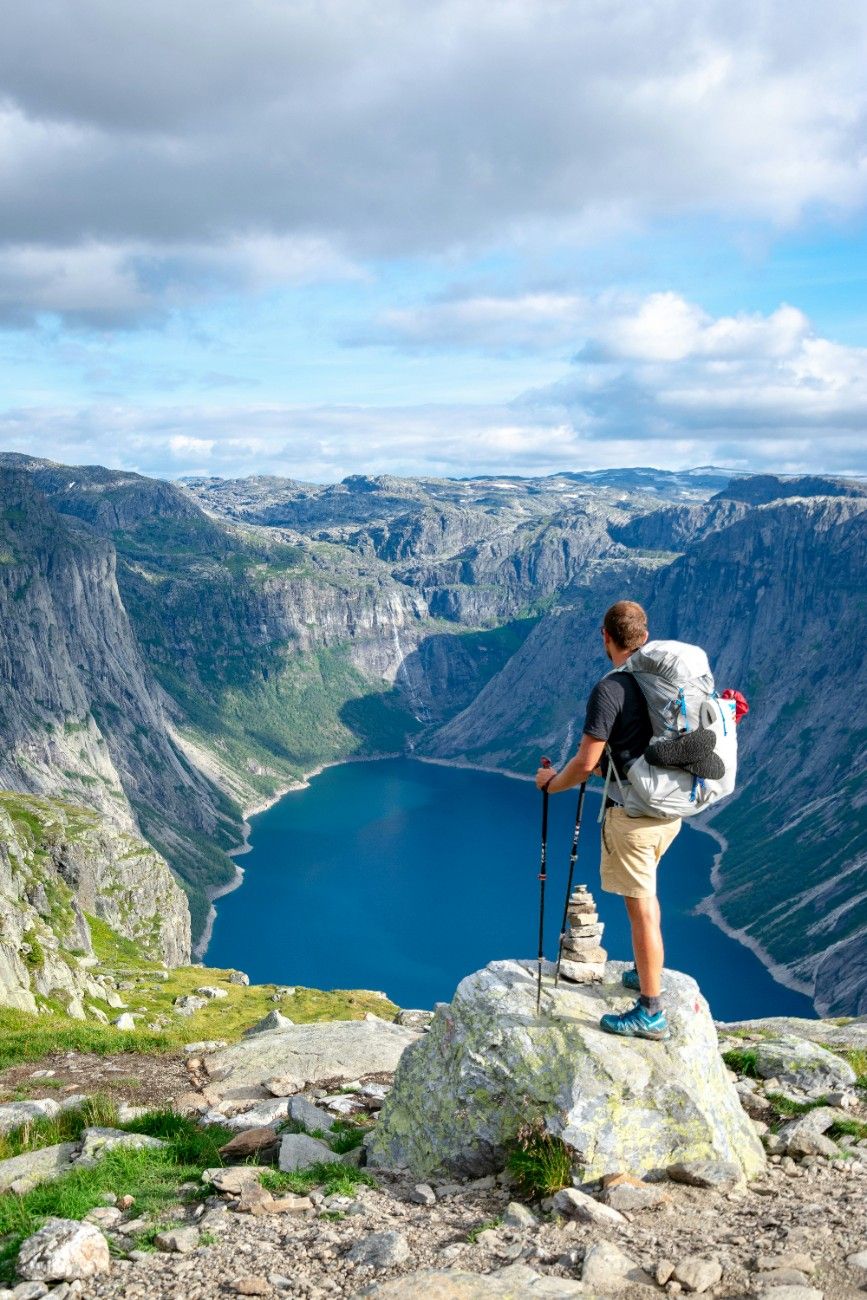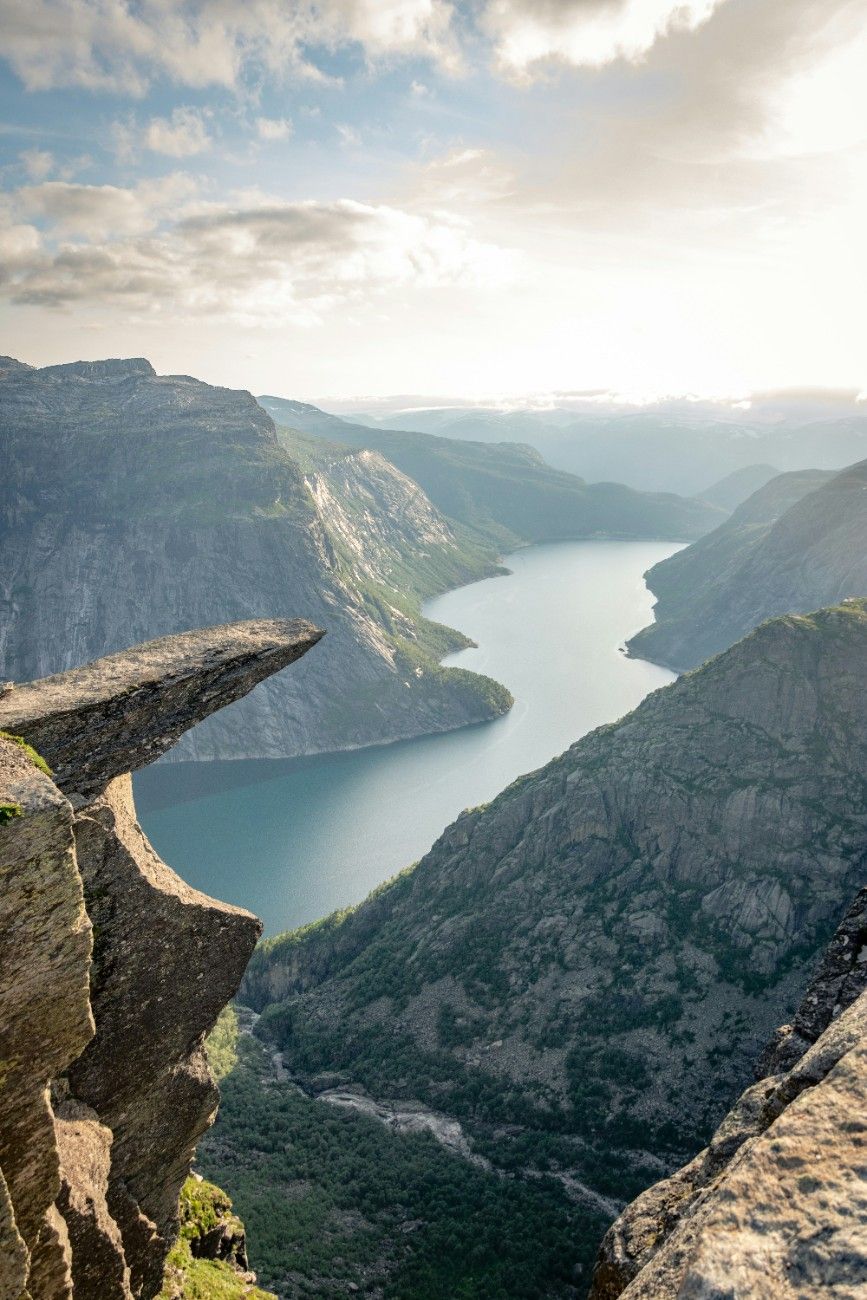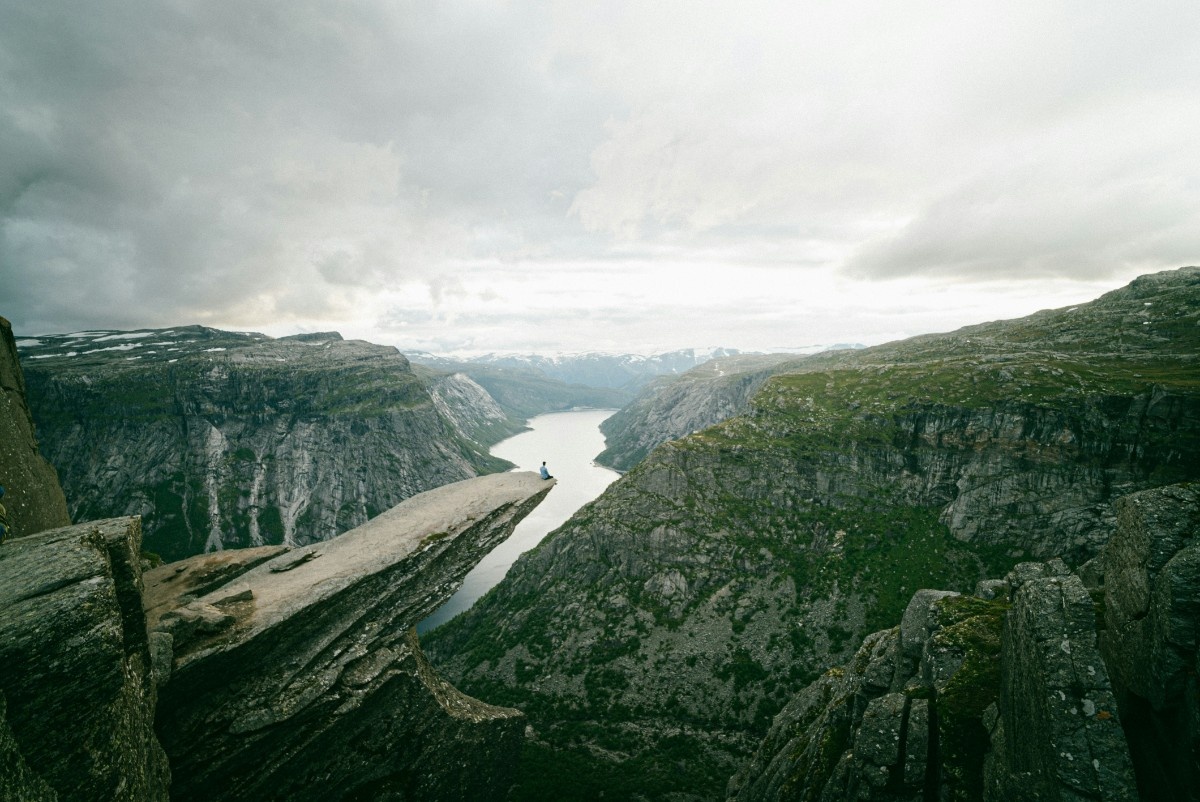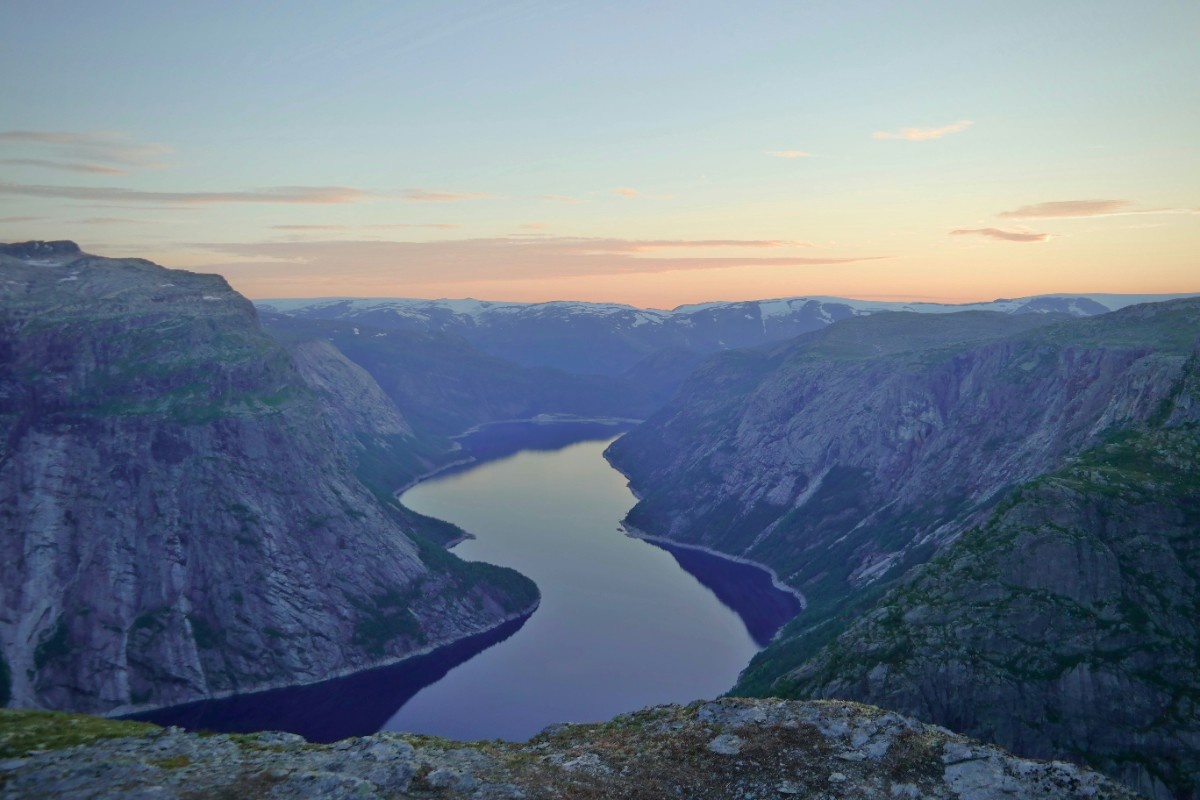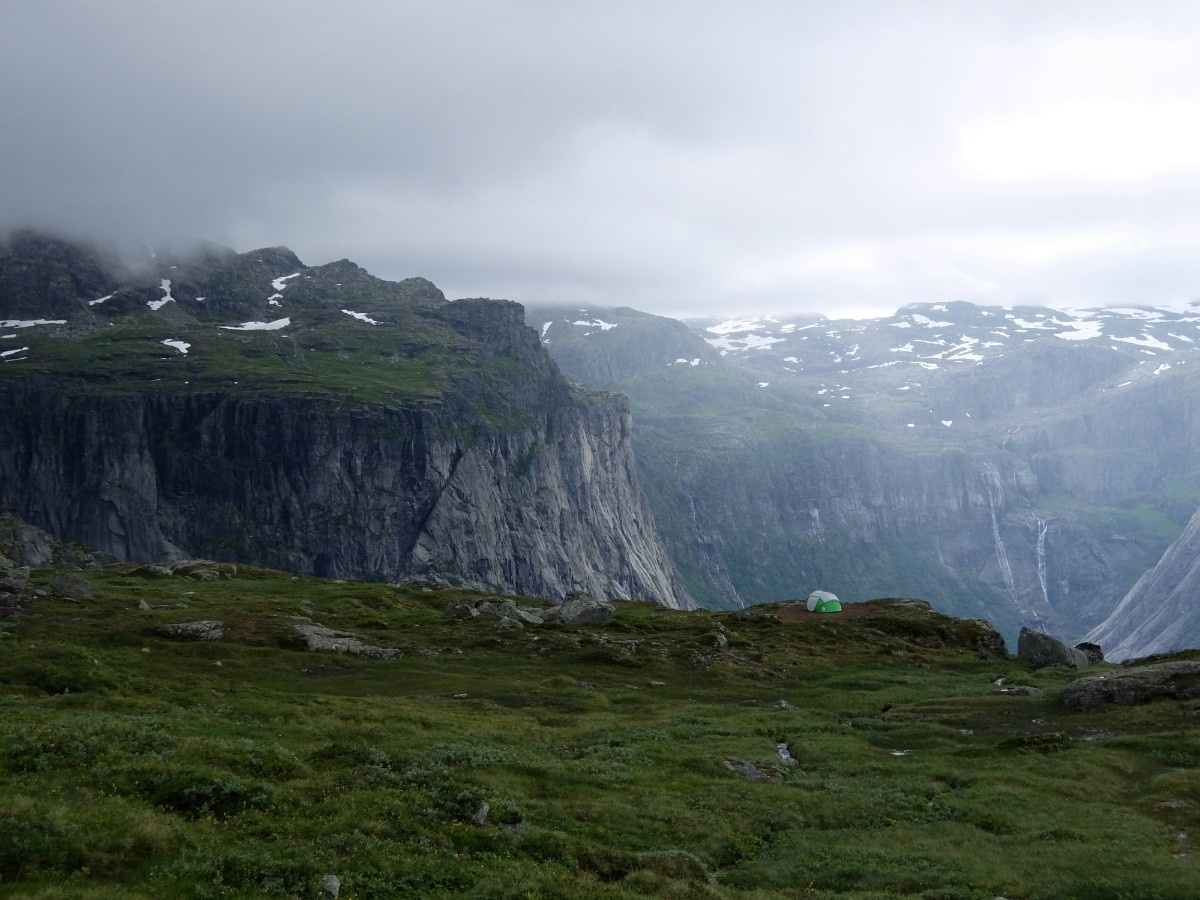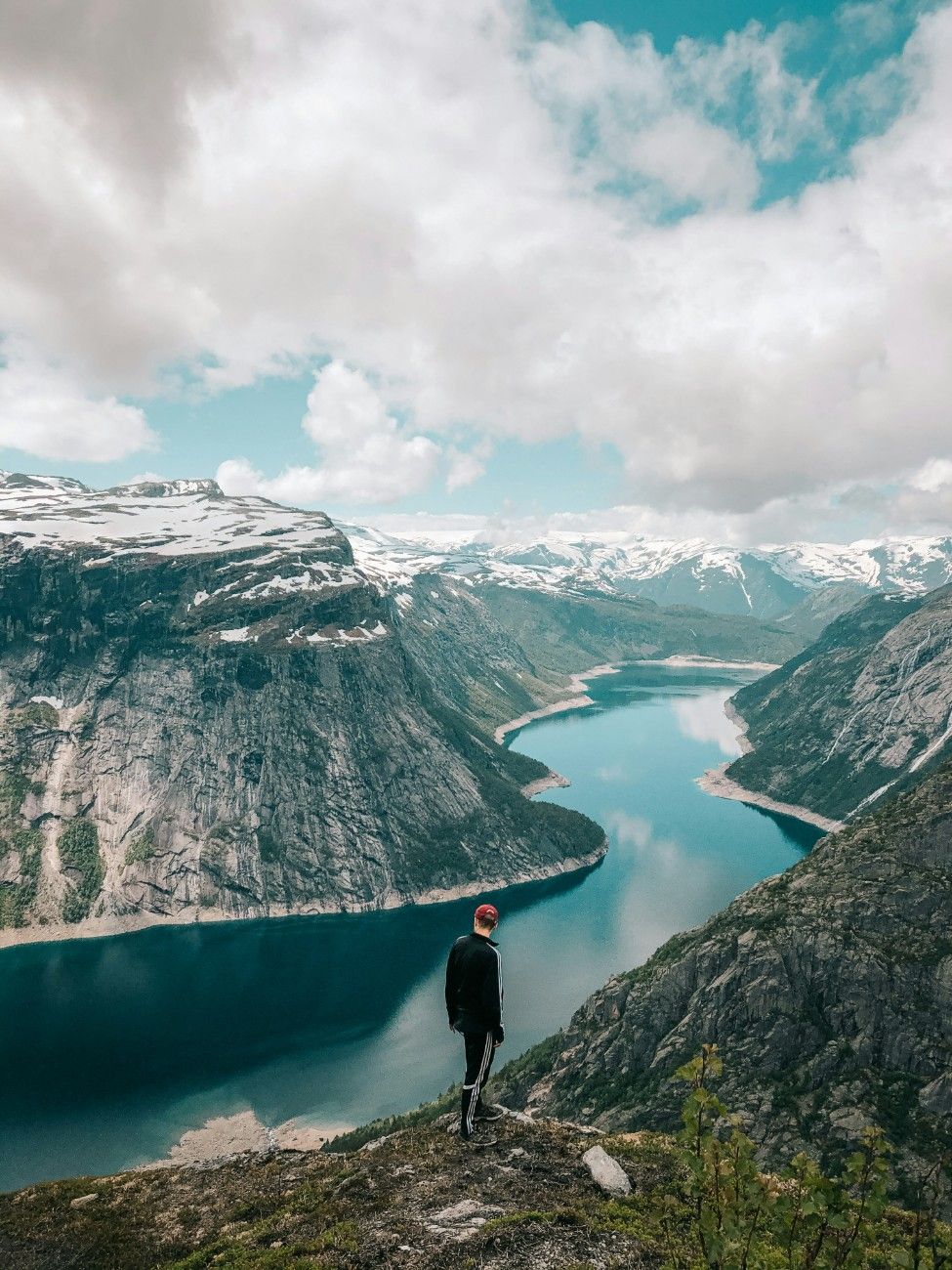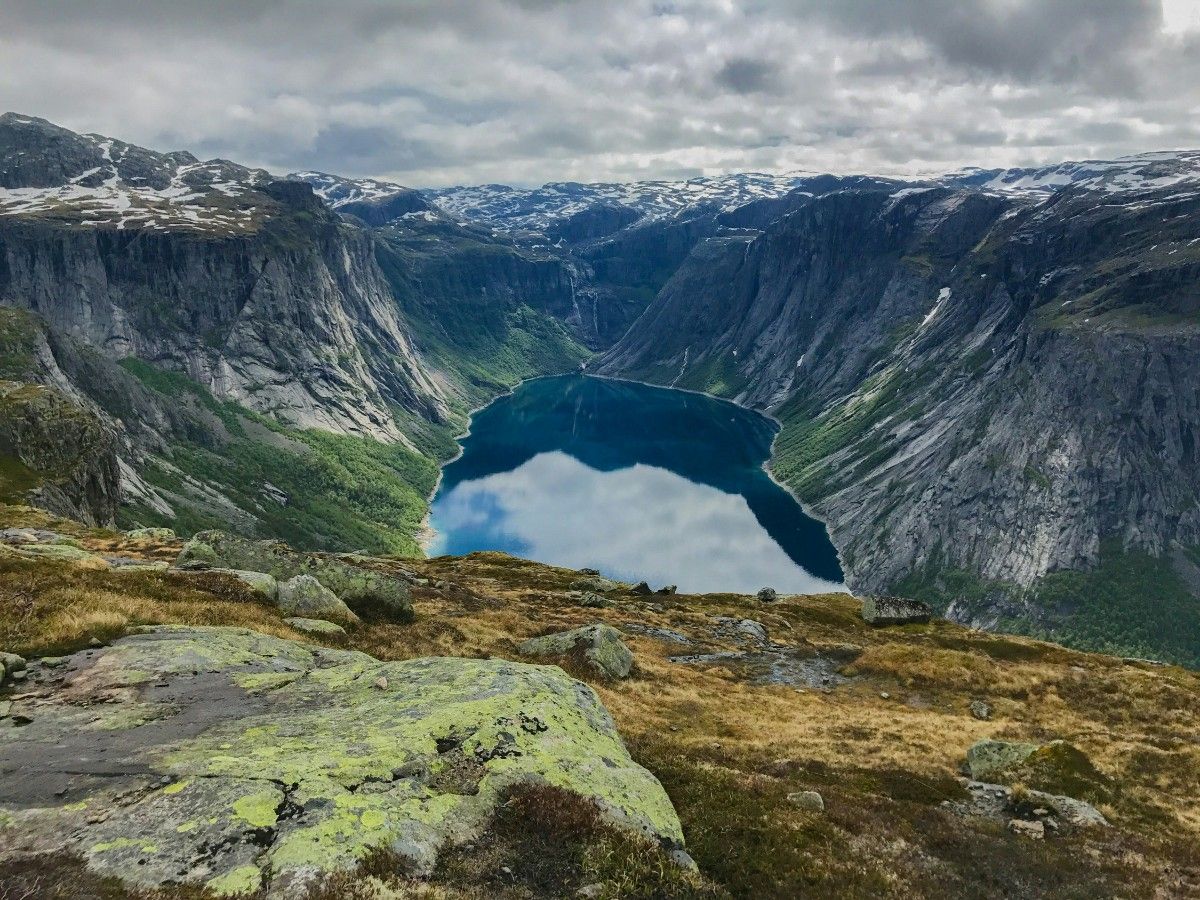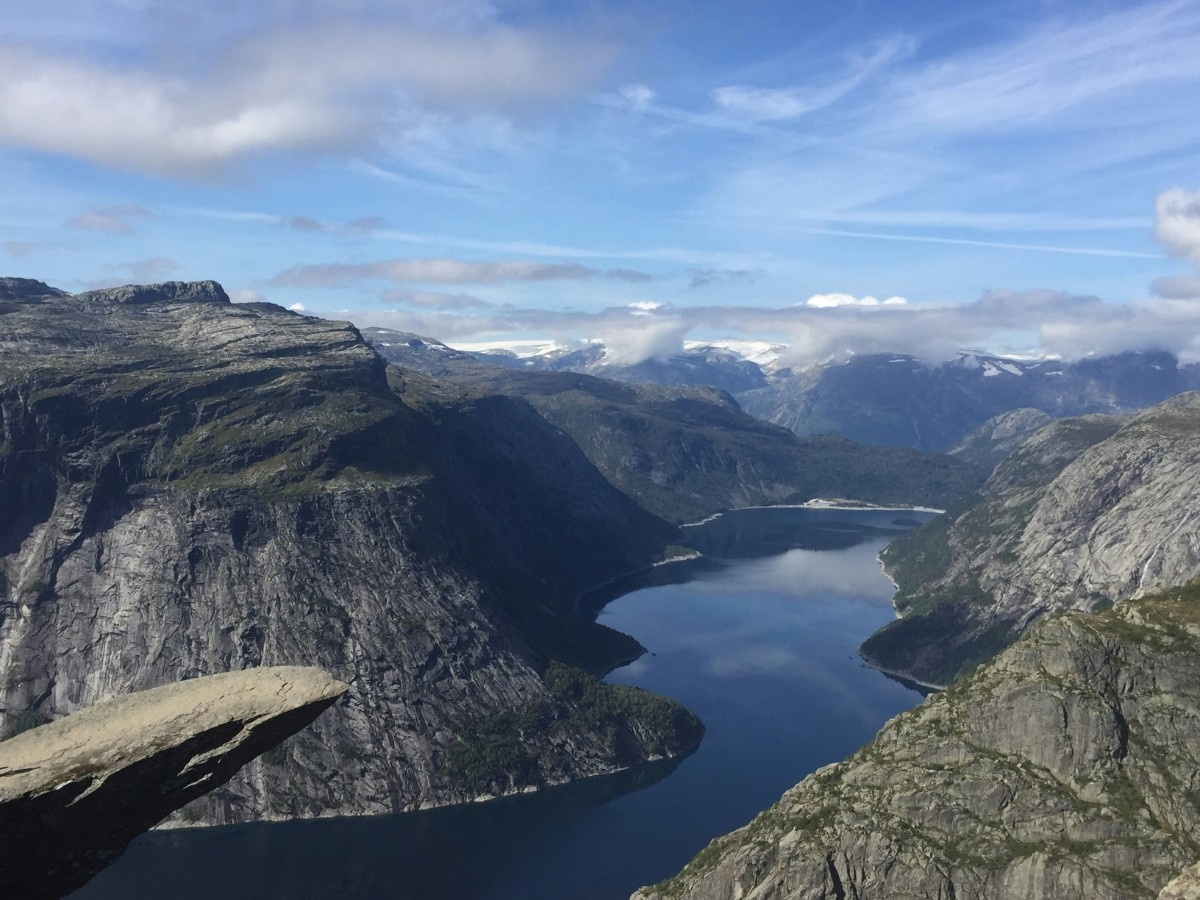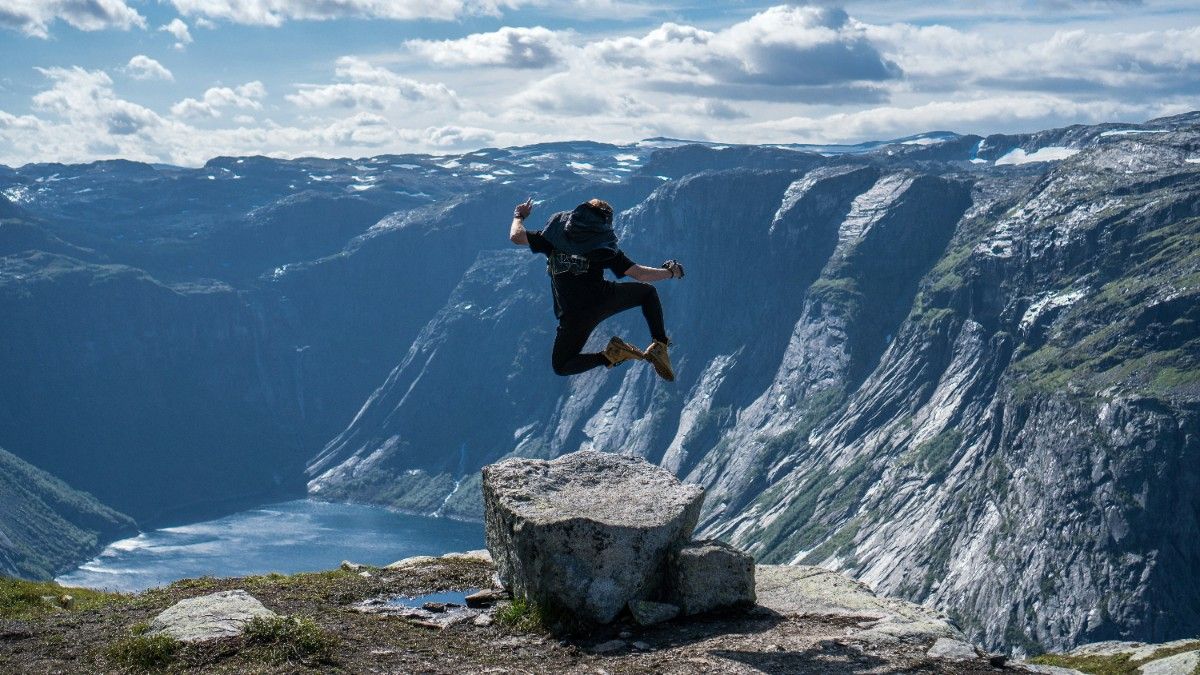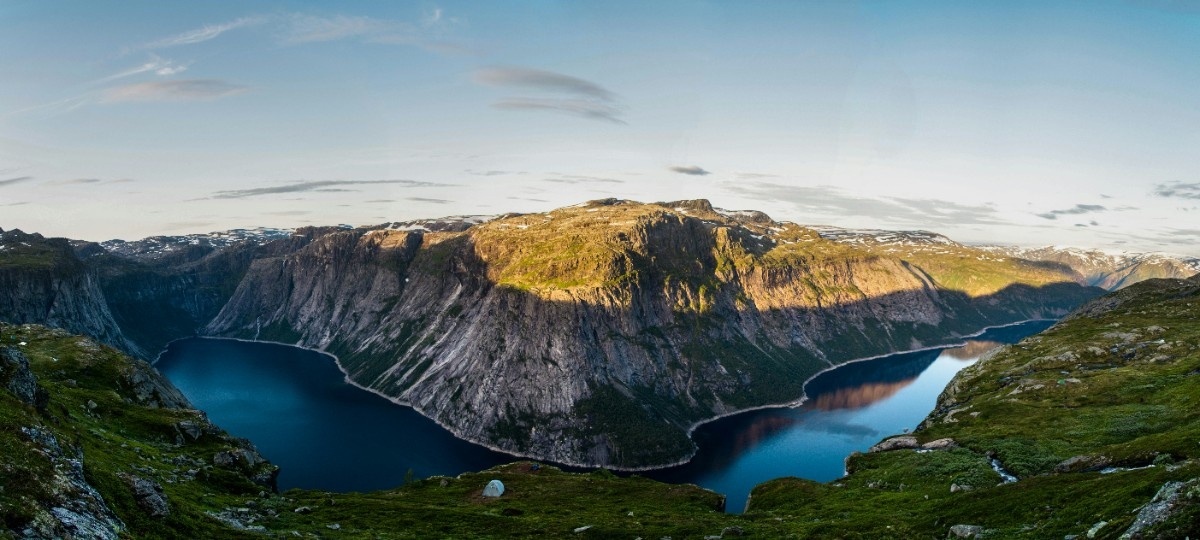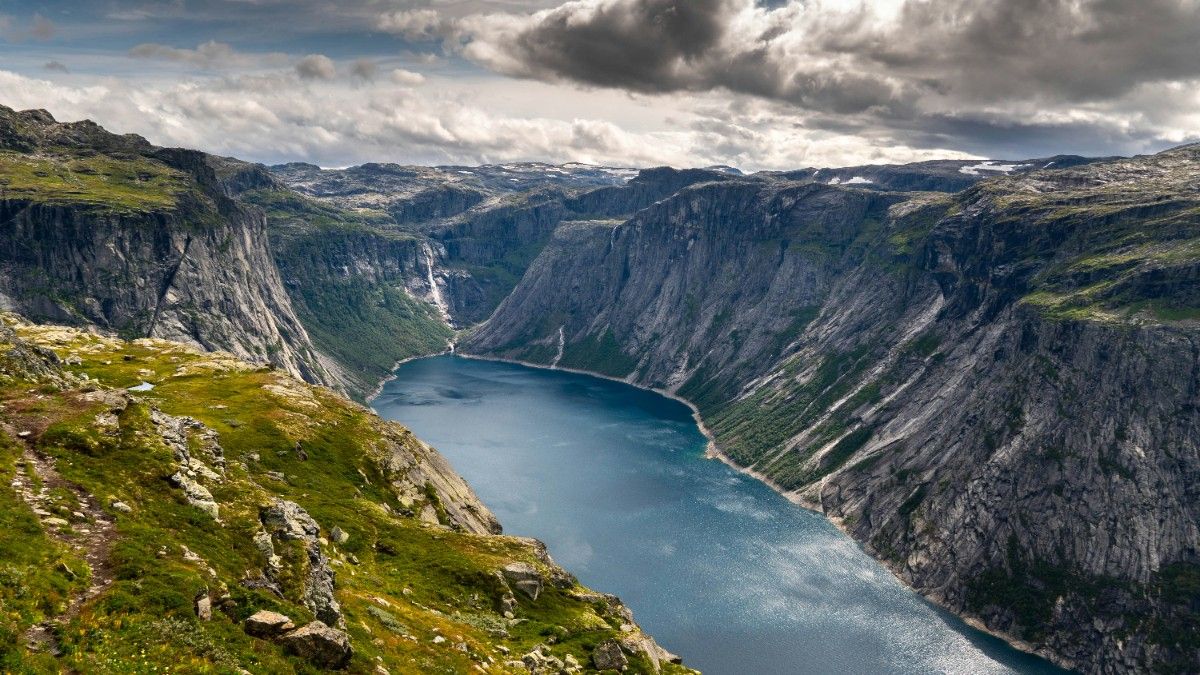Introduction to Trolltunga
What is Trolltunga?
Trolltunga, a breathtaking natural wonder located in the heart of Norway's fjord region, has captivated adventurers and nature enthusiasts from around the world. This iconic rock formation, whose name translates to "Troll's Tongue" in English, is situated in the municipality of Odda, Vestland county. Trolltunga juts out horizontally from a steep cliff face, rising an impressive 700 meters above the crystal-clear waters of Lake Ringedalsvatnet. The awe-inspiring sight of this unique geological feature has made it one of Norway's most popular hiking destinations, attracting thousands of visitors each year who are eager to witness its beauty firsthand and capture unforgettable photographs against the stunning backdrop of the Norwegian wilderness.
The allure of Trolltunga lies not only in its striking appearance but also in the challenging and rewarding hiking experience it offers. The Trolltunga hike is a demanding 27-kilometre round trip that takes hikers through diverse and spectacular landscapes, from lush forests and cascading waterfalls to barren plateaus and steep rock faces. The trail is well-maintained and marked, but it requires a good level of physical fitness and proper preparation to complete safely. Those who undertake the journey are rewarded with unparalleled views of the surrounding mountains, valleys, and fjords, as well as a sense of accomplishment upon reaching the iconic rock formation itself.
Trolltunga's growing popularity has had a significant impact on the local communities of Odda and Tyssedal, which serve as the main gateways to the hiking trail. The influx of tourists has brought economic benefits to the region, with the development of accommodation options, restaurants, and outdoor equipment rental services. However, the increased visitor numbers have also presented challenges in terms of environmental conservation and infrastructure management. Local authorities and organisations have implemented various measures to promote sustainable tourism practices and ensure the preservation of the area's natural beauty for future generations to enjoy.
Location and Accessibility
Trolltunga is located in the municipality of Odda, Vestland county, in western Norway. The rock formation itself is situated approximately 1,100 meters above sea level, overlooking the stunning Ringedalsvatnet lake and the surrounding fjord landscape. The nearest major city to Trolltunga is Bergen, which is located about 150 kilometres to the west and serves as a popular starting point for many visitors.
The most common route to access Trolltunga is by driving or taking public transportation to the town of Odda, which is considered the gateway to the hiking trail. Odda is connected to Bergen and other major cities in Norway by regular bus services, with the journey from Bergen taking approximately 4 hours. From Odda, visitors can continue their journey to the village of Tyssedal, where the trailhead for the Trolltunga hike is located.
For those travelling by car, the drive from Bergen to Odda takes around 3 hours, following the scenic E134 highway. Once in Odda, visitors can follow the Rv13 road towards Tyssedal to reach the starting point of the hike. Parking facilities are available near the trailhead, although spaces can be limited during peak season.
Alternatively, visitors can choose to fly into the nearby airports of Haugesund or Stavanger, which are located approximately 2 hours and 3 hours away from Odda, respectively. From these airports, visitors can rent a car or take a bus to reach Odda and the Trolltunga trailhead.
It is important to note that the accessibility of Trolltunga can be affected by seasonal weather conditions. The hiking trail is typically open from mid-June to mid-September, when the area is free from snow and ice. However, weather conditions can still be unpredictable during this period, and visitors should always check the latest weather and trail updates before embarking on their journey.
Geological Formation and History of Trolltunga
Geological Processes and Rock Composition
The formation of Trolltunga is a testament to the incredible geological forces that have shaped Norway's rugged landscape over millions of years. The rock formation is composed primarily of precambrian bedrock, which includes metamorphic rocks such as gneiss and granite. These ancient rocks, estimated to be between 1.1 and 1.6 billion years old, have undergone significant transformations due to intense heat and pressure deep within the Earth's crust.
The distinct shape of Trolltunga is the result of a combination of geological processes, most notably glacial erosion during the last ice age. Around 10,000 years ago, massive ice sheets covered the region, slowly carving out the dramatic fjords and valleys that characterise western Norway's stunning scenery. As the glaciers advanced and retreated, they eroded the softer rock layers, exposing the more resistant bedrock beneath.
The process of frost wedging also played a crucial role in the formation of Trolltunga. During the ice age, water seeped into cracks and fissures within the rock face, freezing and expanding as temperatures dropped. This repeated cycle of freezing and thawing gradually widened the cracks, weakening the rock structure. Over time, large sections of the cliff face broke away, leaving behind the precariously balanced ledge that we now recognise as Trolltunga.
The rock composition of Trolltunga and the surrounding area is predominantly gneiss, a metamorphic rock known for its distinctive banded appearance. Gneiss is formed when sedimentary or igneous rocks are subjected to high temperatures and pressures, causing the minerals within the rock to segregate into layers. The gneiss found in the Trolltunga region is particularly rich in quartz and feldspar, which contribute to its hardness and resistance to erosion.
In addition to gneiss, the area also features intrusions of granite, another type of igneous rock. These granite intrusions formed when magma solidified deep underground, creating irregular pockets and veins within the surrounding metamorphic rock. The presence of both gneiss and granite in the Trolltunga area is a testament to the complex geological history of the region, which has been shaped by a combination of metamorphic, igneous, and sedimentary processes over hundreds of millions of years.
Historical Significance and Cultural Heritage
While the geological history of Trolltunga spans millions of years, the rock formation has also played a significant role in the cultural heritage of the region. The name "Trolltunga," which translates to "Troll's Tongue" in English, is rooted in Norwegian folklore and mythology. According to local legend, the peculiar shape of the rock formation was created by a mischievous troll who was caught off guard by the rising sun. As the story goes, the troll was so startled by the sunlight that it forgot to retreat into the mountains, causing its tongue to be stuck out in a permanent state of surprise.
This whimsical tale is just one example of how Trolltunga has captured the imagination of the Norwegian people for generations. The rock formation has long been a source of inspiration for artists, writers, and adventurers, who have sought to capture its beauty and mystique through various forms of expression.
In addition to its mythological significance, Trolltunga has also played a role in the historical development of the surrounding region. The nearby town of Odda, which serves as the main gateway to the Trolltunga hike, has a rich industrial heritage tied to the production of zinc and aluminium. The development of these industries in the early 20th century brought significant economic growth and population expansion to the area, transforming Odda from a small rural village into a thriving industrial centre.
As the popularity of Trolltunga as a hiking destination has grown in recent years, the rock formation has become an increasingly important symbol of Norwegian national identity and pride. The iconic image of hikers standing atop the jutting ledge, surrounded by the awe-inspiring beauty of the fjord landscape, has become a widely recognised representation of Norway's natural wonders and adventurous spirit.
Today, Trolltunga serves not only as a popular tourist attraction but also as a reminder of the deep connection between Norway's stunning landscapes and its rich cultural heritage. The rock formation stands as a testament to the enduring power of nature to shape both the physical environment and the human imagination, inspiring generations of Norwegians and visitors from around the world to explore and appreciate the breathtaking beauty of the fjord region.
Hiking to Trolltunga: Preparation and Trail Information
Physical Fitness and Experience Level
Embarking on the Trolltunga hike is an incredible adventure that rewards those who are well-prepared and physically fit. The 27-kilometer round trip journey is considered a challenging hike, with steep ascents, rocky terrain, and exposed sections that can be demanding even for experienced hikers. It is essential to assess your own fitness level and hiking experience before setting out on the trail.
To comfortably complete the Trolltunga hike, it is recommended that hikers have a good level of physical fitness and endurance. The trail involves a total elevation gain of around 800 meters, with some steep and prolonged ascents that can be taxing on the legs and lungs. Hikers should be prepared to spend 10 to 12 hours on the trail, depending on their pace and the number of breaks taken.
Previous hiking experience, particularly on longer and more challenging trails, is highly beneficial when attempting the Trolltunga hike. Familiarity with navigating rugged terrain, maintaining a steady pace, and being comfortable with heights can all contribute to a safer and more enjoyable experience.
It is important to note that the Trolltunga hike is not recommended for young children, those with mobility issues, or individuals with certain health conditions. If you have any concerns about your ability to complete the hike safely, it is always best to consult with a medical professional or an experienced hiking guide before setting out.
For those who are unsure about their fitness level or hiking experience, it may be helpful to start with shorter and less strenuous hikes in the area, such as the Lilletopp or the Buarbreen glacier hike, to build up strength and confidence before attempting Trolltunga. Alternatively, guided hikes with experienced local guides can provide additional support and expertise for those who want to experience the trail with an added level of safety and comfort.
Essential Gear and Equipment
Having the right gear and equipment is crucial for a safe and successful Trolltunga hike. The following list outlines the essential items that every hiker should pack:
- Sturdy hiking boots with good ankle support and a grippy sole
- Comfortable and moisture-wicking hiking socks
- Breathable, quick-drying hiking trousers or shorts
- Layers of clothing, including a base layer, insulating mid-layer, and waterproof outer layer
- Warm hat, gloves, and a buff or neck gaiter
- Backpack with a hip belt and chest strap for comfort and support
- Plenty of water and a water filtration system or water treatment tablets
- High-energy snacks and a packed lunch
- First-aid kit, including blister plasters, bandages, and any personal medications
- Map and compass or GPS device (and the knowledge to use them)
- Headtorch or torch with extra batteries
- Sunscreen, sunglasses, and a hat for sun protection
- Insect repellent (depending on the season)
- Camera or phone to capture the stunning views (but remember to pack a portable charger)
It is important to choose high-quality, durable gear that is specifically designed for hiking and outdoor use. Investing in proper equipment can make a significant difference in your comfort and safety on the trail.
When packing your backpack, make sure to distribute the weight evenly and keep frequently used items, such as water and snacks, easily accessible. A well-fitting backpack with a hip belt and chest strap can help reduce strain on your shoulders and back, making the hike more comfortable.
Before setting out on the Trolltunga hike, take the time to test your gear and break in your hiking boots to avoid blisters and discomfort on the trail. It is also a good idea to familiarise yourself with the use of any new equipment, such as a GPS device or water filtration system, before your hike.
By being thoroughly prepared with the right gear and equipment, you can focus on enjoying the incredible scenery and challenge of the Trolltunga hike, while minimising the risk of discomfort or injury along the way.
Best Time to Visit Trolltunga and Weather Considerations
Seasonal Weather Patterns and Trail Conditions
The best time to visit Trolltunga and embark on the iconic hike is during the summer months, typically from mid-June to mid-September. This period offers the most favourable weather conditions and the longest daylight hours, allowing hikers to safely complete the challenging trail and enjoy the stunning views from the famous rock formation.
However, it is important to note that the weather in the Norwegian mountains can be unpredictable and change rapidly, even during the summer season. Trolltunga is located in a region known for its variable weather patterns, with the possibility of rain, wind, and low temperatures at any time of the year.
In June, the trail conditions may still be affected by lingering snow and ice, particularly in the higher elevations. The weather can also be cooler and wetter compared to later in the summer. However, June offers the advantage of longer daylight hours, with the sun setting as late as 11 pm, providing ample time to complete the hike.
July and August are considered the peak months for hiking Trolltunga, with generally more stable and warmer weather conditions. Average daytime temperatures can range from 12°C to 18°C (54°F to 64°F), although it can feel cooler at higher elevations and in exposed areas. It is still essential to be prepared for rain and wind, as these conditions can occur at any time.
As September approaches, the weather becomes increasingly unpredictable, with a higher likelihood of rain, cooler temperatures, and shorter daylight hours. The trail may also become more slippery and muddy due to the wetter conditions. However, September can also offer the opportunity to experience the stunning autumn colours in the surrounding landscape, making for a unique and picturesque hiking experience.
Regardless of the time of year, it is crucial to check the weather forecast and trail conditions before setting out on the Trolltunga hike. The Norwegian Meteorological Institute provides detailed weather reports and forecasts for the area, which can be accessed online or through their mobile app. It is also a good idea to check with local tourist information centres or hiking associations for up-to-date information on trail conditions and any potential hazards.
Avoiding Crowds and Peak Season
The popularity of Trolltunga as a hiking destination has soared in recent years, with thousands of visitors flocking to the trail during the summer months. While the peak season offers the best weather conditions, it also comes with the challenge of larger crowds and potential congestion on the trail.
To avoid the largest crowds and enjoy a more peaceful hiking experience, consider planning your visit to Trolltunga during the shoulder months of June or September. While the weather may be slightly more unpredictable, the trails are often quieter, and the changing colours of the surrounding landscape can be particularly beautiful.
If you do plan to hike Trolltunga during the peak months of July and August, it is recommended to start your hike early in the morning to avoid the busiest times on the trail. Many hikers choose to begin their journey before sunrise, not only to avoid crowds but also to witness the breathtaking views of the sunrise over the fjords.
Another option to consider is hiking on weekdays rather than weekends, as the trail tends to be less crowded during the week. This can also make it easier to find parking at the trailhead and secure accommodation in the nearby towns of Odda or Tyssedal.
It is important to remember that even during the quieter periods, the Trolltunga hike remains a popular and well-travelled trail. Hikers should always be prepared to encounter other people on the trail and practice good hiking etiquette, such as yielding to uphill hikers, keeping a respectful distance from others, and properly disposing of any waste.
By being mindful of the peak season and taking steps to avoid the largest crowds, hikers can ensure a more enjoyable and serene experience on the Trolltunga hike, while still being able to witness the awe-inspiring beauty of this iconic Norwegian landmark.
Accommodation Options near Trolltunga
Hotels and Guesthouses in Odda
When planning your Trolltunga hike, choosing the right accommodation is essential for a comfortable and convenient stay. The town of Odda, located approximately 30 kilometres from the trailhead, offers a variety of accommodation options to suit different budgets and preferences.
One of the most popular choices among hikers is the Trolltunga Hotel, a modern and well-appointed property in the heart of Odda. This hotel offers a range of room types, from standard singles to family rooms and suites, catering to both solo travellers and groups. The hotel features an on-site restaurant serving delicious Norwegian cuisine, as well as a bar and lounge area where guests can relax after a long day on the trail. The Trolltunga Hotel is an excellent choice for those seeking a comfortable and convenient base from which to explore the area.
Another recommended option in Odda is the Hardanger Hotel, a charming and historic property that has been welcoming guests since the early 1900s. This hotel offers a mix of traditional and modern rooms, each equipped with comfortable amenities and tasteful décor. The Hardanger Hotel also features an on-site restaurant and bar, as well as a cozy lounge area with a fireplace, perfect for unwinding after a day of hiking.
For those on a tighter budget, the Odda Camping site offers a range of affordable accommodation options, including cabins, apartments, and tent pitches. Located just a short walk from the centre of Odda, this camping site provides a convenient and cost-effective base for hikers. The site features shared kitchen and bathroom facilities, as well as a small shop selling basic groceries and hiking supplies.
In addition to these options, Odda also offers a selection of guesthouses, B&Bs, and self-catering apartments, providing hikers with a wide range of accommodation choices to suit their needs and preferences.
Mountain Lodges and Camping near the Trailhead
For those who prefer to stay closer to the Trolltunga trailhead, there are several mountain lodges and camping options available in the nearby area.
One popular choice is the Trolltunga Guesthouse, located just 13 kilometres from the trailhead in the village of Tyssedal. This cozy guesthouse offers both private rooms and dormitory-style accommodation, making it a great option for solo travellers and small groups. The guesthouse features a shared kitchen and living area, as well as a small shop selling snacks and hiking essentials. Guests can also enjoy stunning views of the surrounding mountains from the property's outdoor terrace.
Another nearby option is the Skjeggedal Camping site, situated just 2 kilometres from the trailhead. This camping site offers a range of accommodation options, including cabins, apartments, and tent pitches, set against a backdrop of breathtaking mountain scenery. The site features shared kitchen and bathroom facilities, as well as a small café serving light meals and refreshments. Skjeggedal Camping is an ideal choice for hikers who want to minimise their travel time to the trailhead and enjoy a more immersive outdoor experience.
For a truly unique accommodation experience, hikers can also choose to stay at the Reinaskorsbu DNT Cabin, a rustic mountain lodge located along the Trolltunga hiking route. This self-service cabin, operated by the Norwegian Trekking Association (DNT), offers basic accommodation in a stunning natural setting. Hikers must bring their own sleeping bags and food, and be prepared to share the cabin with other hikers. While the amenities are basic, staying at the Reinaskorsbu DNT Cabin allows hikers to fully immerse themselves in the wilderness and experience the true spirit of the Trolltunga hike.
When choosing your accommodation for the Trolltunga hike, it is essential to book well in advance, especially during the peak summer months when demand is highest. By securing your accommodation early, you can ensure a comfortable and stress-free stay, allowing you to focus on the incredible hiking experience that awaits you.
Getting to Trolltunga: Transportation and Logistics
Travelling by Car from Bergen to Odda
One of the most convenient ways to reach Trolltunga is by travelling by car from the city of Bergen to the town of Odda, which serves as the gateway to the hiking trail. The journey from Bergen to Odda is approximately 150 kilometers and takes around 3 hours, depending on traffic and road conditions.
To begin your journey, follow the E16 highway east from Bergen towards Voss. This scenic route takes you through the stunning Norwegian countryside, passing by picturesque villages and stunning fjord landscapes. After around 100 kilometers, you will reach the town of Voss, where you will need to take the E13 highway towards Granvin.
From Granvin, continue following the E13 highway for approximately 30 kilometers until you reach the intersection with the Rv13 road. Turn left onto the Rv13 and follow this road for another 20 kilometers until you reach the town of Odda.
Once in Odda, you will need to navigate to the village of Tyssedal, where the Trolltunga trailhead is located. From the centre of Odda, follow the Rv13 road towards the north for approximately 7 kilometers until you reach the turn-off for Tyssedal. Follow the signs for the Trolltunga parking area, which is located at the end of the road in Skjeggedal.
It is important to note that the road from Odda to Skjeggedal is narrow and winding, with some steep sections. Drivers should exercise caution and allow plenty of time for the journey, especially during peak season when traffic can be heavier.
When planning your trip by car, it is also essential to consider parking arrangements at the trailhead. The parking area at Skjeggedal has limited spaces and can fill up quickly during peak season. It is recommended to arrive early in the morning to secure a parking spot, especially during the summer months.
Public Transportation Options from Bergen to Odda
For those who prefer not to drive, there are several public transportation options available for travelling from Bergen to Odda and the Trolltunga trailhead.
The most common and convenient option is to take a bus from the Bergen bus terminal (Bystasjonen) to Odda. Several bus companies operate regular services along this route, including Skyss and Tide. The journey takes approximately 4 hours and offers stunning views of the Norwegian countryside and fjords along the way.
Buses depart from the Bergen bus terminal several times a day, with more frequent services during the summer months. It is recommended to book your bus tickets in advance, especially during peak season, to ensure availability and secure your preferred travel times.
Once you arrive in Odda, you will need to transfer to a local bus or taxi to reach the Trolltunga trailhead in Skjeggedal. Local buses operate between Odda and Tyssedal, with connections to the trailhead. These buses run less frequently than the main Bergen to Odda service, so it is important to plan your journey accordingly and check the local bus schedules in advance.
Alternatively, you can take a taxi from Odda to the trailhead, which offers a more flexible and direct option. Taxis can be pre-booked or hailed from the taxi rank in the centre of Odda. Keep in mind that taxi fares can be relatively expensive, especially for the 7-kilometre journey from Odda to Skjeggedal.
When planning your public transportation journey to Trolltunga, it is essential to allow plenty of time for connections and potential delays. It is also a good idea to check the latest travel information and timetables before setting out, as schedules can vary depending on the season and may be subject to change.
Safety Tips and Responsible Hiking Practices
Essential Safety Precautions for the Trolltunga Hike
The Trolltunga hike is a challenging and rewarding experience, but it also comes with inherent risks that hikers must be aware of and prepared for. To ensure a safe and enjoyable hike, it is crucial to follow essential safety precautions and guidelines.
One of the most important safety considerations is to be properly equipped for the hike. This means wearing sturdy hiking boots with good ankle support and grip, as well as comfortable and moisture-wicking clothing layers. The weather conditions at Trolltunga can change rapidly, so it is essential to pack warm and waterproof layers, even during the summer months.
Hikers should also carry a well-stocked backpack with essential supplies, including plenty of water, high-energy snacks, a first-aid kit, and a map or GPS device. It is recommended to bring at least 2 litres of water per person, as well as a water filtration system or purification tablets in case of emergencies.
Another crucial safety tip is to hike with a partner or in a group, especially if you are not an experienced hiker. The buddy system ensures that there is always someone to help in case of an emergency or injury. If you do choose to hike alone, make sure to inform someone of your planned route and expected return time, and carry a means of communication, such as a mobile phone or emergency beacon.
It is also essential to be aware of the potential hazards along the Trolltunga trail, such as steep drop-offs, loose rocks, and slippery surfaces. Hikers should stay on the marked trail at all times and avoid taking shortcuts or venturing too close to the edge of the cliff. The iconic rock formation itself can be particularly dangerous, especially in wet or windy conditions, so hikers should exercise extreme caution when approaching the ledge and avoid taking unnecessary risks for photographs.
In case of an emergency, hikers should know how to contact the local emergency services and be familiar with basic first-aid procedures. The emergency number in Norway is 112, and it is recommended to save this number in your phone before setting out on the hike.
By following these essential safety precautions and being prepared for the challenges of the Trolltunga hike, hikers can minimise the risks and ensure a safe and enjoyable experience in this stunning natural landscape.
Practicing Responsible and Sustainable Hiking at Trolltunga
In addition to ensuring personal safety, it is also crucial for hikers to practice responsible and sustainable hiking practices at Trolltunga to help preserve the natural beauty and ecological integrity of the area for future generations.
One of the most important principles of responsible hiking is to practice Leave No Trace (LNT) ethics. This means leaving the environment as you found it, without leaving any trace of your presence behind. Hikers should pack out all trash and waste, including food scraps and toilet paper, and dispose of it properly in designated waste receptacles.
It is also essential to stay on the marked trail and avoid trampling on vegetation or disturbing wildlife. The fragile alpine ecosystem at Trolltunga is particularly vulnerable to damage from human impact, so hikers should be mindful of their footsteps and avoid taking shortcuts or creating new trails.
When nature calls, hikers should follow proper backcountry toilet practices, which means burying human waste in a cathole at least 15 centimetres deep and 60 meters away from water sources, trails, and camping areas. Toilet paper should be packed out or buried with the waste.
Hikers should also be respectful of other visitors and the local community by practicing good trail etiquette, such as yielding to uphill hikers, keeping noise levels down, and being courteous to others. The increasing popularity of Trolltunga has put a strain on the local infrastructure and resources, so it is important for hikers to be mindful of their impact and support local businesses and initiatives that promote sustainable tourism practices.
Finally, hikers can also contribute to the conservation and maintenance of the Trolltunga trail by volunteering with local organisations, such as the Norwegian Trekking Association (DNT), which works to promote sustainable outdoor recreation and maintain hiking trails throughout Norway.
By practicing responsible and sustainable hiking practices at Trolltunga, hikers can help ensure that this incredible natural wonder remains accessible and pristine for generations to come, while also respecting the rights and livelihoods of the local community.
Trolltunga's Cultural Significance and Impact on Local Communities
The Legend and Folklore of Trolltunga
Trolltunga, with its unique and striking appearance, has long been a source of fascination and inspiration for the Norwegian people. The name itself, which translates to "Troll's Tongue" in English, is rooted in Norwegian folklore and mythology, reflecting the deep cultural significance of this natural wonder.
According to local legend, Trolltunga was formed by a mischievous troll who was caught off guard by the rising sun. As the story goes, the troll was so startled by the sunlight that it forgot to retreat into the mountains, causing its tongue to be stuck out in a permanent state of surprise. This whimsical tale is just one example of how Trolltunga has captured the imagination of the Norwegian people for generations.
In Norwegian folklore, trolls are often depicted as large, grotesque creatures that inhabit the mountains and forests, often with a penchant for causing mischief and mayhem. They are said to turn to stone when exposed to sunlight, which explains the petrified appearance of many rock formations throughout Norway, including Trolltunga.
The legend of Trolltunga has been passed down through generations, inspiring countless stories, artworks, and songs that celebrate the beauty and mystery of this iconic landmark. The rock formation has become a symbol of the Norwegian landscape and a testament to the enduring power of folklore and mythology in shaping cultural identity.
Today, visitors from around the world are drawn to Trolltunga not only for its stunning natural beauty but also for its rich cultural heritage. The hike to the rock formation offers a chance to connect with the landscape and the stories that have shaped it, creating a deep sense of place and belonging.
As Trolltunga continues to gain popularity as a hiking destination, it is important to remember and respect the cultural significance of this natural wonder. By sharing the stories and legends that surround Trolltunga, we can help preserve its cultural legacy and ensure that future generations can continue to be inspired by its beauty and mystery.
Economic and Social Impact on Local Communities
The growing popularity of Trolltunga as a hiking destination has had a significant impact on the local communities of Odda and Tyssedal, bringing both opportunities and challenges for the region.
On the positive side, the influx of tourists has brought economic benefits to the area, creating new jobs and businesses in the tourism and hospitality sectors. The increased demand for accommodation, food, and transportation services has led to the development of new hotels, restaurants, and tour operators, providing a boost to the local economy.
The revenue generated from tourism has also allowed for investment in local infrastructure and amenities, such as improved roads, parking facilities, and public restrooms, which benefit both visitors and residents alike. The local government and tourism organisations have also used the popularity of Trolltunga to promote other attractions and activities in the region, such as glacier hikes, kayaking, and cultural heritage sites, helping to diversify the tourism offering and spread the benefits more widely.
However, the rapid growth of tourism has also brought challenges and concerns for the local communities. The increased foot traffic on the Trolltunga trail has led to issues of overcrowding, trail erosion, and environmental degradation, putting pressure on the fragile alpine ecosystem. The local authorities and hiking associations have had to invest in trail maintenance, safety measures, and visitor management strategies to mitigate these impacts and ensure a sustainable future for the area.
The influx of visitors has also put a strain on local resources and infrastructure, such as housing, healthcare, and waste management, leading to concerns about the carrying capacity of the region and the quality of life for residents. Some locals have expressed frustration with the disruption caused by tourism, such as increased traffic, noise, and litter, and the feeling of being overwhelmed by the sheer number of visitors during peak season.
To address these challenges, the local communities and tourism stakeholders have been working together to develop sustainable tourism strategies and initiatives that balance the economic benefits of tourism with the need to protect the environment and preserve the social and cultural fabric of the region. This includes efforts to promote responsible hiking practices, support local businesses and initiatives, and engage visitors in the conservation and stewardship of the area.
As Trolltunga continues to attract visitors from around the world, it is important for hikers to be mindful of their impact on the local communities and to support sustainable tourism practices that benefit both the environment and the people who call this place home. By working together, we can ensure that Trolltunga remains a source of natural beauty, cultural inspiration, and economic vitality for generations to come.
Related Articles

Let us know you agree to cookies
We use marketing, analytical and functional cookies as well as similar technologies to give you the best experience. Third parties, including social media platforms, often place tracking cookies on our site to show you personalised adverts outside of our website.
We store your cookie preferences for two years and you can edit your preferences via ‘manage cookies’ or through the cookie policy at the bottom of every page. For more information, please see our cookie policy.
